The assumption that one kid with autism is like the other is all wrong as the variability in interests and communication abilities is quite pronounced in each one of them. As such, it is not always easy to foresee which kid will be a better communicator than the other, and which speech therapy treatment and experiences would lead to positive and thus better results.
Fortunately, speech researchers have been constantly researching on which skills and experiences in early child’s life lead to effective communication later on in their lives. By recognizing the key skills, speech therapists are then able to focus on the main areas so as to offer the kids a good start in their communication skills. Here are the three main skills that lead to better communication abilities or results for kids living with autism:
Joint attention
This is about taking part in the same undertaking by wholesomely focusing on it, but with other people around the kid, for example exploring and then talking about the same event or object. For instance, a small kid with his mother or father sharing a common focal point on a specific item, such as looking at an awesome mountain, bird, car, and etc. For this to work, the child needs to discover how to:
• Initiate joint attention: This is drawing the parent’s attention to an item of interest.
• Respond to something of common focus: This means noticing an item that another person, in this case the parent, is drawing his attention to.
Joint attention offers kids the chance to hear their parent’s use of words about an object of interest right away so that they are able to pay attention to that event or object. This way, they are able to learn to learn words for familiar objects and learn that older people can provide details about their world.
Toy play
Toys related to communication improvement come in two categories; pretend play and functional toy play.
• Pretend play: This entails envisaging with toys, for example, pretending to put gasoline in a toy truck, feeding a doll, cooking in a toy kitchen with toy appliances, and so forth.
• Functional play: This entails utilizing toys in expected ways, for instance, pushing a car, putting a marble onto a ramp in order for it to run down to the bottom, putting a puzzle piece in a puzzle, etc.
Imitation
This is the ability to copy other people’s body movements, facial movements, sounds, and actions with play or real objects. Imitation is directly related to a child’s ability to effectively communicate with people around him or her. If unable to imitate sounds, actions, etc, then the kid is never able to communicate effectively with others, even later on in life. Imitation helps kids to become aware of what other people are doing and then copy and interact with them.
Young kids in this regard learn to bond with close people, for example, mothers, fathers, brothers and sisters etc, in early enough, (prior to learning to talk), by observing them and then copying their every actions, sounds and smiles. This way, they are able to learn different new skills, talking and playing included.
Difficulties with toy play, imitation and joint attention is normally seen in all small kids with autism between ages 8 to 20 months. This is quite important in that when these difficulties are identified at this age, then both the parents and speech therapists in CT are able to focus on them so as to intervene as early as possible in order to promote proper communication development.



